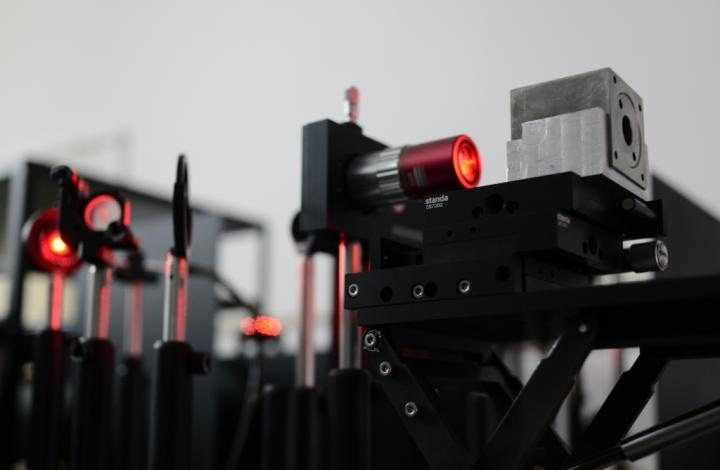Sep 9 2016
 During the search for compounds for hydrogen storage, a new material has been discovered with exceptionally high negative compressibility. Pictured above: measurement equipment used in experiments in the Institute of Physical Chemistry of the Polish Academy of Sciences in Warsaw. (Credit: IPC PAS, Grzegorz Krzyzewski)
During the search for compounds for hydrogen storage, a new material has been discovered with exceptionally high negative compressibility. Pictured above: measurement equipment used in experiments in the Institute of Physical Chemistry of the Polish Academy of Sciences in Warsaw. (Credit: IPC PAS, Grzegorz Krzyzewski)
Intuition suggests that when a material sample is compressed uniformly from all sides it will decrease in size. Only a few materials exhibit the opposite behavior, by slightly expanding in a couple of directions when subjected to hydrostatic compression.
Researchers from the Institute of Physical Chemistry of the Polish Academy of Sciences (IPC PAS) have discovered a new material that has extremely high negative compressibility and a mechanism behind it that was previously unknown.
These materials elongate along one or two directions when hydrostatic pressure is applied. An accidental, yet interesting discovery was made at the Institute of Physical Chemistry of the Polish Academy of Sciences (IPC PAS) in Warsaw, when researchers were searching for optimal compounds essential for hydrogen storage. One of the materials that was being tested exhibited a significant elongation under increased pressure.
Usually the increase in dimensions observed in materials with negative compressibility subjected to high hydrostatic pressure is small. We are talking here about values of the order of a single percentage point or even less. We have found a material of very high negative compressibility, of up to 10% in one direction. Interestingly, the elongation occurred abruptly at a pressure of approx. 30 thousand atmospheres.
Dr. Taras Palasyuk, IPC PAS
Dr. Palasyuk is involved in the study of materials subjected to hydrostatic pressures of one to several million atmospheres (the prefix hydro- means that there is a uniform pressure on the material from all sides). In laboratories diamond anvils are used to produce such high pressures, when micrometer-sized samples are placed between the anvils.
The sample is placed in a seal to ensure that the pressure is exerted uniformly on the test material. The anvil is compressed with a screw to increase the pressure. A ruby crystal is placed next to the sample to serve as a pressure gauge. Based on the pressure exerted the ruby changes its fluorescence.
The volume of the sample material decreases as is subjected to the increasing pressure. This decrease is associated with the decrease in all the spatial dimensions.
But, there are atypical crystalline materials which experience a decrease in volume because of thermodynamics, during compression when simultaneously the crystal elongates in one or two directions. The mechanism behind this is geometrical, when subjected to pressure the individual elements in the crystal moved in relation to each other at different degrees in different directions.
In our laboratory using laser light we analyzed how the manners of vibration of molecules in the crystal changed with increasing pressure and on this basis we drew conclusions about the structure of the material. We quickly discovered that in the crystal we were examining, which was sodium amidoborane, the elongation could not be explained by changes in geometry alone.
Ewelina Magos-Palasyuk, PhD Student, IPC PAS
Sodium amidoborane, with the chemical formula Na(NH2BH3), is an easily accessible compound that forms transparent crystals with an orthorhombic structure. Research conducted on the crystals of this compound by employing Raman spectroscopy at IPC PAS was compared with theoretical model predictions.
It was found that the elongation of the chemical bonds between hydrogen and nitrogen, and nitrogen and boron, which is the result of the sudden creation of new hydrogen bonds among the adjacent crystal molecules, is the reason behind the negative compressibility of sodium amidoborane crystals.
Sodium amidoborane is thus the first material known to us where the negative compressibility is primarily of a chemical nature.
Dr. Taras Palasyuk, IPC PAS
He stresses that unlike other materials where there is a change in the symmetry of the crystal structure as a result of high pressure, there are no significant changes in sodium amidoborane. He adds: "Our preliminary results, obtained by X-ray diffraction at the National Synchrotron Radiation Research Center in Taiwan, also confirm that the material retains its original symmetry. It is precisely because it does not have to rebuild that the increase in the linear dimensions occurs here in such an abrupt manner."
This new discovery of a previously unknown mechanism that can cause negative compressibility can give birth to the search for new materials that have similar rare physical properties. The first application has already been thought of.
These crystals can be used for components of detectors of a specific threshold pressure of around 30,000 atmospheres (pressure up to 300,000 atmospheres are used in industry) because of their sudden, significant and reversible increase in length. Active bulletproof vests that can serve as airbags in a car when subjected to sudden increase in pressure by the missile strike are another potential application of sodium amidoborane.